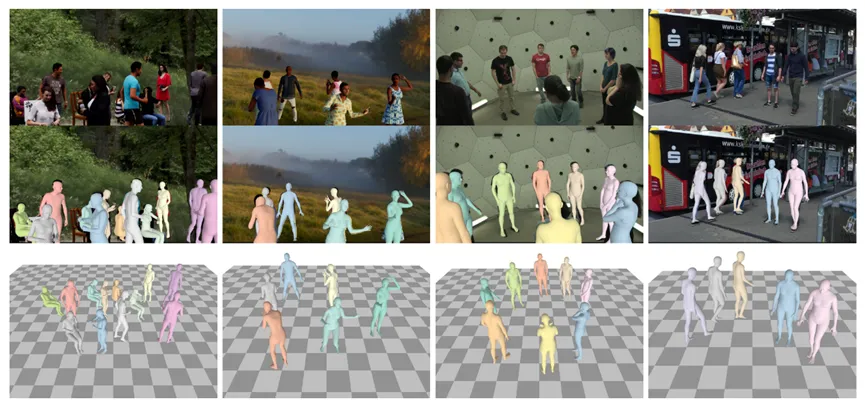As 3D human modeling pushes into new frontiers of realism and precision, the biggest challenge is no longer modeling architecture — it’s data.
1. Rethinking the Backbone of 3D Human Modeling
High-quality 3D human reconstruction relies on a solid modeling foundation. The SMPL-X model, with 24 joint rotations and 10 shape parameters, supports 6,890 mesh vertices — covering body, hands, and facial details.
The breakthrough came with SAT-HMR (Scale-Adaptive Tokens for Human Mesh Recovery), introduced by Su et al. at CVPR 2025. This method eliminates the traditional trade-off between mesh accuracy and real-time performance by dynamically distributing computational resources.
Key innovations in SAT-HMR include:
-
Adaptive token allocation
- Small-scale targets (e.g., distant figures): high-resolution tokens preserve detail
- Large-scale subjects: low-resolution tokens reduce redundancy
- Background regions: spatial pooling reduces compute load by 70%
-
Real-time inference pipeline
- Transformer encoder enables 24 FPS mesh outputs
- 35mm accuracy improvements for distant figures
- 70% reduction in compute for near-field scenes
-
Efficiency at scale
- Bio-inspired attention mechanisms deliver near-SOTA accuracy
- Operates at just 1/46 the computational cost
2. Real-World Use Cases: Mesh Data Driving Real Impact
SAT-HMR, backed by accurate mesh annotations, is already powering real-world systems across multiple industries. Here’s how:
Smart Surveillance with Multi-Modal Perception (CurvePoint AI)
- Combines stereo vision and Wi-Fi sensing
- Achieves joint error under 1cm, even under occlusion
- Enables real-time pose detection with 3D tactical heatmaps
- Performance improves by 40% in low-light or obstructed environments
Tactical Simulation Training (maadaa.ai)
- Built on SAT-HMR and SMPL-X modeling
- Enables real-time, high-precision pose capture
- Delivers vertex error under 1cm
- Reduces annotation costs by 60% across over 100,000 mesh samples
E-Commerce Virtual Try-On (Zalando)
- Utilizes Multi-HMR (ECCV 2024) for fast 3D avatar generation
- Creates avatars in just 5 seconds
- Flow: Upload photo → Get avatar → Real-time try-on
- Results: Return rates reduced by 35% (Zalando 2024 report)
Clinical Gait Analysis (NYU)
- Uses SMPL-X and motion capture for medical applications
- Tracks Parkinson’s gait metrics and recovery
- Maintains joint angle error under 3 degrees
3. The Hidden Battlefield: Where Mesh Data Becomes the Bottleneck
Even with advanced models, performance collapses without clean, reliable data. The biggest challenges lie not in algorithm design, but in data collection, processing, and labeling.
Data Collection

Data Processing
- Cleaning: 40% invalid frames (e.g., blur, occlusion) filtered via spatiotemporal smoothing
- Fusion: Stereo & Wi-Fi sync <0.1ms using hardware triggers
- Compute: 4K video = 1.2TB/hour → optimized via keyframe sampling and SAT-HMR background token compression
Annotation Challenges
Annotation is often the most time-consuming and expensive step in mesh pipeline development. That’s why we built a system to automate it — and are now offering it to you.

4. maadaa.ai’s Scalable Data Pipeline: From Concept to 100K+ Meshes
By building on the SAT-HMR architecture, maadaa.ai has developed a robust and scalable 3D dataset creation platform — capable of producing high-quality human mesh annotations efficiently and at scale.
System Enhancements:
- Stereo Depth Augmentation
Optimized multi-camera setups improve depth accuracy, even in challenging lighting or occluded environments. - SMPL→SMPL-X Conversion
Enables detailed modeling of the human body, hands, and facial structure, expanding the application scope from general motion capture to expressive avatar generation and clinical biomechanics. - Auto Labeling Toolkit
Provides precision XYZ adjustment and full 3D-to-2D projection alignment, ensuring structural consistency across modalities.
Results:
To date, the platform has delivered over 100,000 high-quality mesh annotations across industries including simulation, healthcare, and e-commerce — with measurable improvements in accuracy, efficiency, and training outcomes.
5. Full-Stack Mesh Annotation and Deployment Ecosystem
Our platform offers more than just labeling — it provides a complete toolchain for mesh data generation, analysis, and deployment.
Model Compatibility
- Multi-HMR: multi-person, single-image mesh recovery
- SAT-HMR: real-time multi-person estimation
- SMPL/SMPL-X: extensible full-body modeling
Tooling Suite
- Web-based 3D viewer with rotation, pose overlays
- Multi-view rendering with auto labeling (ID and height included)
- Stereo-aware projection tools
Data Engineering Pipeline
- Batch video processing with fault tolerance
- Auto timestamp matching and retry logic
- Configurable settings: focal length, batch size, token resolution
Validation & Analytics
- Rotation consistency checks
- Error heatmaps (under 1cm joint/vertex error)
- Parameter synchronization (rotvecs, joint updates)
- NPZ comparisons for model benchmarking
- Excel + LLM integration for annotation review
- Unified modal handling for images, meshes, and labels
Deployment
- One-click CLI interface
- Cross-platform Docker environments
- Real-time web UI with keyboard shortcuts and feedback tool
6. Lessons from the Field
"In 3D reconstruction, algorithms set the ceiling — but data defines the floor. Our precision labeling system brought mesh alignment error to industry-low levels."
— Eric, Tech Lead at maadaa.ai
References
- Su et al. “SAT-HMR”, CVPR 2025
- Baradel et al. “Multi-HMR”, ECCV 2024
- Pavlakos et al., CVPR 2019
- CurvePoint AI: Advanced Wi-Fi Sensing
- Zalando Virtual Fitting Room, 2024 Report



